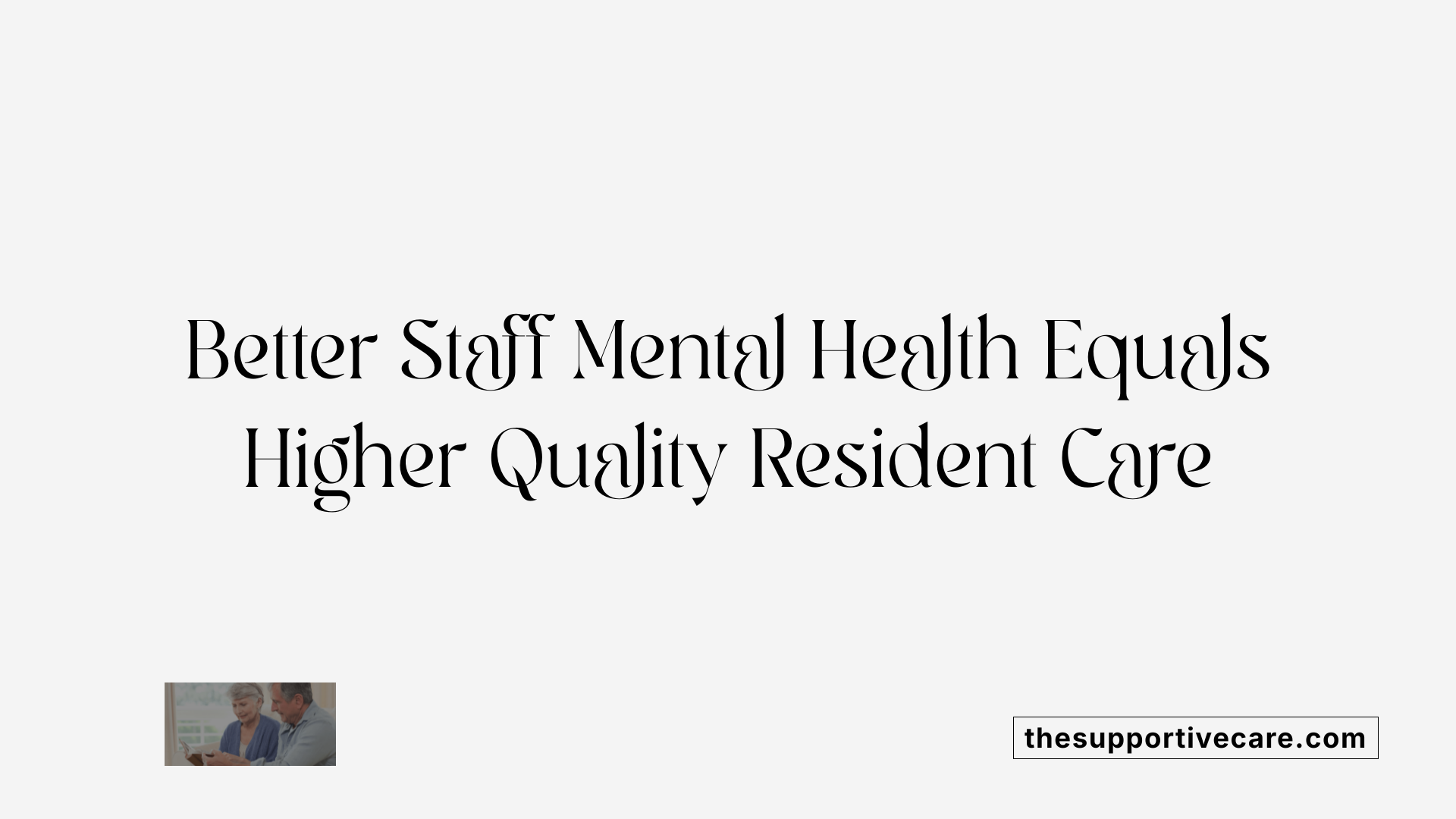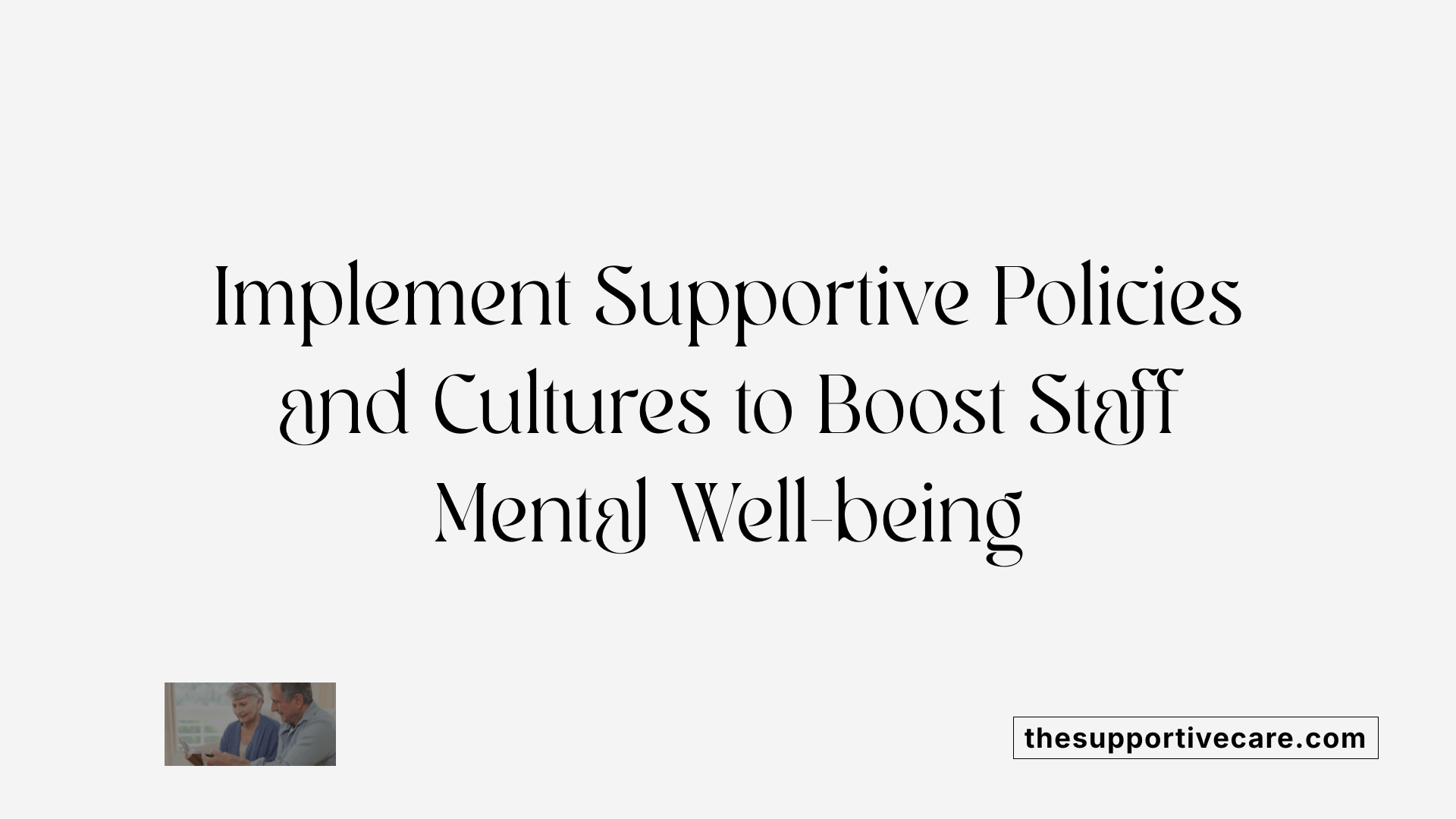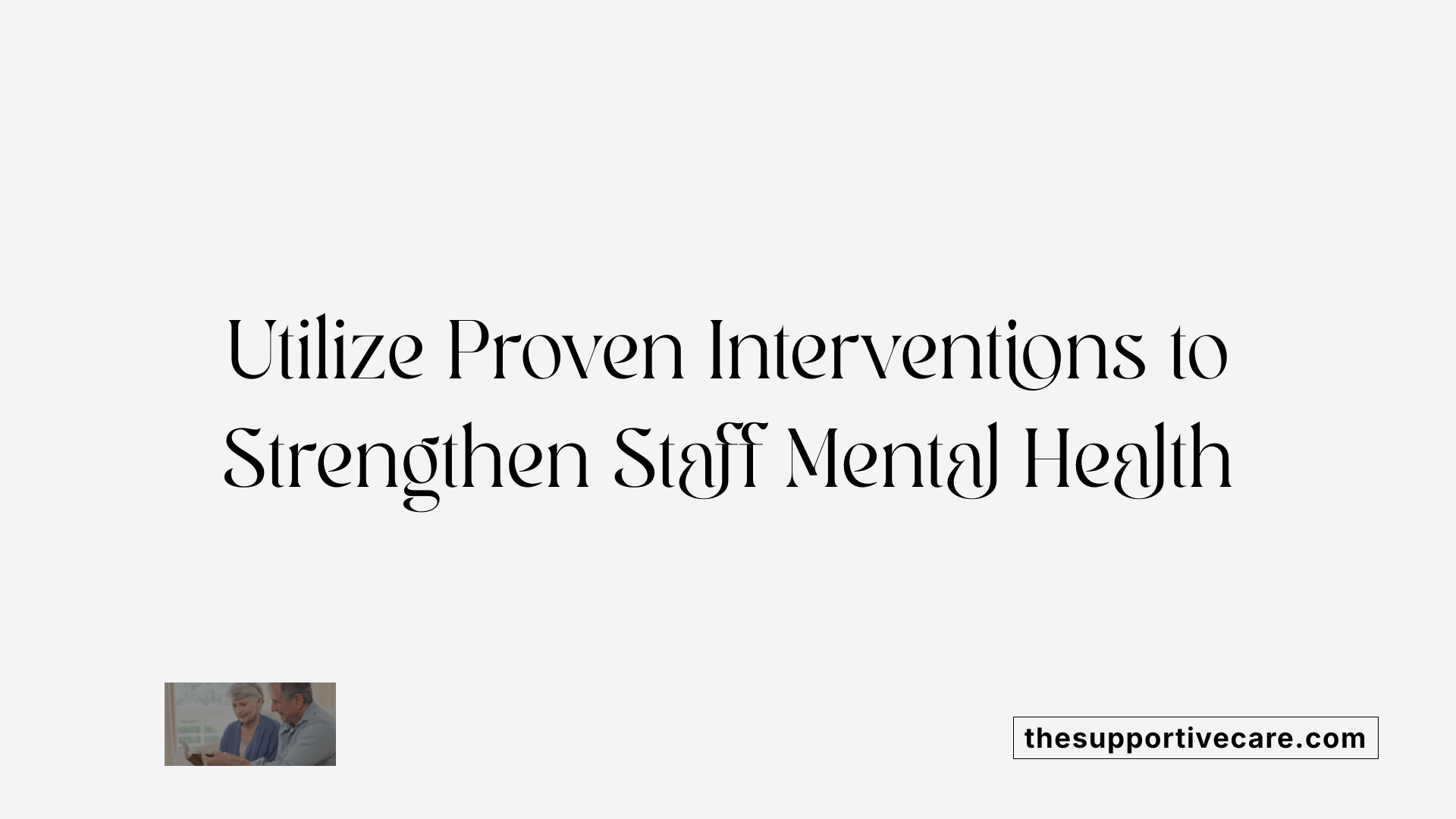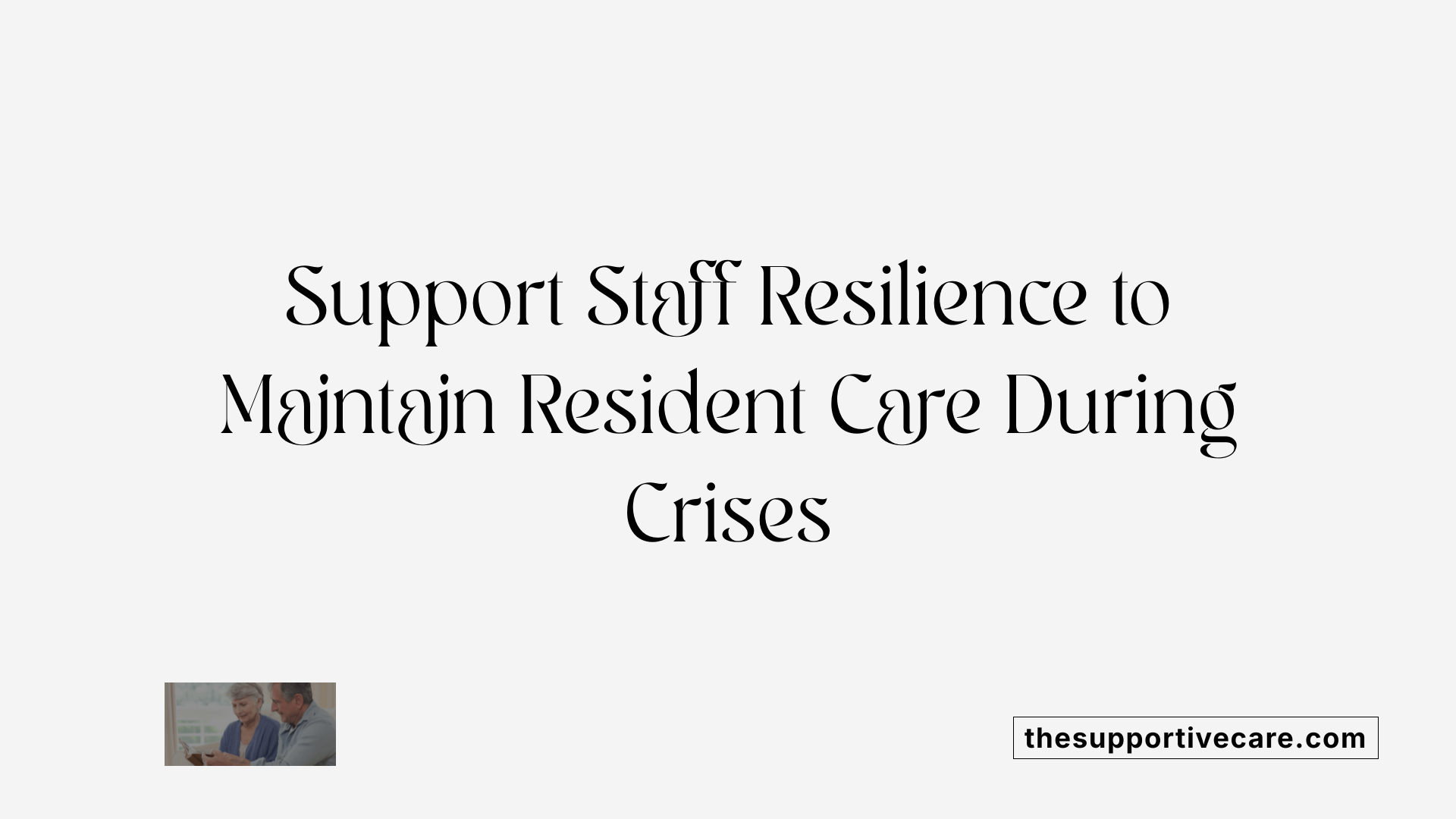Understanding the Critical Link Between Staff Mental Health and Resident Outcomes
Supporting the mental health of staff working in senior care settings is fundamental to delivering high-quality, compassionate care to residents. Burnout, compassion fatigue, and stress not only affect caregivers but also have a direct impact on residents' safety, comfort, and overall well-being. This article explores best practices, evidence-based interventions, and organizational strategies that facilitate a healthier work environment, thereby improving the quality of care and resident satisfaction.
The Impact of Staff Mental Health on Resident Care Quality

How does supporting staff mental health impact the quality of resident care?
Supporting staff mental health in senior living and long-term care facilities is essential not just for the well-being of care providers but also for the quality of care residents receive. When staff members maintain good mental health, their ability to communicate clearly, exercise sound judgment, and provide compassionate, person-centered care substantially improves.
Many studies highlight that emotionally healthy staff are less prone to errors, which enhances safety outcomes such as the prevention of pressure sores, urinary tract infections (UTIs), and other preventable issues. Better mental health contributes to more attentive bedside care, proactive problem-solving, and a calming presence for residents.
Creating a work environment that supports mental wellness involves several strategies. Tailoring working conditions to address specific stressors faced by different nursing groups—considering safety concerns and work-life balance—can foster a sense of autonomy and cohesion among staff. Such improvements not only reduce burnout and compassion fatigue but also encourage staff to form stronger, more meaningful relationships with residents.
When staff are supported psychologically, they tend to engage more actively with residents, promoting interactions that bolster residents’ social and emotional health. It’s well-documented that positive staff-resident relationships contribute to residents’ overall happiness and mental well-being.
Furthermore, healthier staff contribute significantly to clinical outcomes. They are more vigilant in infection control, better at identifying early signs of deterioration, and more consistent in following care protocols. This reduces the incidence of preventable complications, ensures safer environments, and minimizes the risk of medical errors.
Investing in mental health resources, such as access to counseling, stress management training, and organizational support, directly correlates with improved resident safety and satisfaction. Facilities that prioritize staff well-being often see measurable enhancements in care quality metrics.
How does supporting staff mental health improve safety outcomes such as pressure sore and UTI prevention?
Staff mental health directly influences their capacity to perform routine yet critical safety practices. For instance, attentive staff who are not overwhelmed or burned out are more vigilant in repositioning residents to prevent pressure sores and maintaining strict hygiene protocols that prevent UTIs.
When staff experience fatigue or burnout, their attentiveness declines, increasing the likelihood of missed early warning signs. Conversely, mental wellness efforts promote mindfulness and focus, leading to more consistent and thorough care practices.
Moreover, a positive work environment encourages open communication among team members, ensuring that concerns about skin integrity or infection risks are promptly addressed. This proactive approach significantly lowers the chance of adverse events, promoting a safer, more responsive environment.
What is the link between staff well-being, resident engagement, and social support?
Residents flourish when supported by staff who are emotionally balanced and engaged. Well-supported staff are more likely to foster meaningful interactions, which promote residents’ social involvement and psychological health.
Enhanced social support within the care environment also benefits staff, creating a reciprocal dynamic of well-being. When residents are engaged in activities, they experience better mood and decreased loneliness, which in turn reduces staff stress by decreasing behavioral issues and confrontation.
Programs that emphasize resident engagement—such as activities, family involvement, and community partnerships—are most effective when staff members are motivated, well-trained, and emotionally resilient. Initiatives like team-building, mental health training, and recognition can elevate staff morale, creating a positive cycle that benefits both residents and staff.
In sum, the relationship between staff mental health and resident care quality is profound. Adequately supporting staff not only improves safety and clinical outcomes but also enriches the social and emotional environment vital for residents’ health. This holistic approach fosters a culture of compassion, safety, and engagement, which is essential for excellence in long-term care.
| Aspect | Impact | Additional Details |
|---|---|---|
| Communication and judgment | Improved clarity and decision-making | Better mental health reduces errors and mishandling of care situations |
| Compassionate care | Higher emotional involvement | Staff are more empathic and attentive to residents’ needs |
| Safety outcomes | Reduced infections and pressure sores | Vigilance and routine practices are sustained with staff well-being |
| Resident engagement | Increased participation and satisfaction | Supportive staff foster social connections and sense of community |
| Clinical safety | Fewer adverse events | Early detection of health issues leads to timely intervention |
| Staff-resident relationships | Stronger bonds | Positive interactions promote feelings of security and belonging |
Fostering staff mental health is thus a strategic approach that enhances multiple facets of resident care, paving the way for safer, more compassionate, and effective long-term care environments.
Strategies and Practices for Supporting Staff Well-Being

What strategies and best practices can be implemented to support the psychological well-being of staff in senior care settings?
Supporting staff mental health in senior living environments requires a comprehensive approach that addresses multiple levels of influence, from individual to organizational and systemic factors. Implementing effective strategies involves fostering a culture of support, open communication, and ongoing education.
At the micro-level, organizations should prioritize regular mental health assessments for staff. These assessments can identify early signs of stress, burnout, or compassion fatigue, enabling timely interventions. Providing access to mental health resources such as counseling, peer support groups, and resilience training programs equips staff with coping techniques to manage emotional challenges.
Professional development is another crucial component. Training in emotion regulation, trauma-informed care, and de-escalation strategies enhances staff confidence and competence, reducing feelings of helplessness and burnout. Recognizing staff achievements through appreciation programs and creating a culture that values their contributions promotes a sense of belonging and morale.
On the meso-level, improving workplace conditions is vital. Efforts should focus on reducing workload and emotional demands, which are linked to higher stress levels. Ensuring adequate staffing ratios, providing sufficient resources, and fostering positive professional relations through team-building activities help create a supportive work environment.
Effective leadership plays a pivotal role in staff well-being. Managers who communicate transparently, model healthy work practices, and engage staff in decision-making foster trust and a sense of empowerment. Regular team meetings and feedback sessions can address concerns and promote collaborative problem-solving.
Systemic, macro-level interventions are essential for sustainable change. Advocating for policies that improve staffing standards, fair wages, and safe working conditions can significantly reduce stressors. Structural reforms in governance, ownership models, and funding streams can also influence the overall workload and resource availability.
Creating integrated policies that merge staffing adequacy with mental health support creates a more resilient workforce. Incorporating mental health standards into accreditation and quality assurance frameworks ensures accountability and continuous improvement.
In addition, embedding mental health services into routine care, such as through accessible crisis intervention programs and staff mental health days, reduces stigma and encourages utilization of available support.
A well-rounded strategy emphasizes a holistic approach—combining individual resilience training, organizational support practices, and systemic reforms—ensuring that staff are not only supported in the moment but also protected from systemic workplace stressors.
Summary of Multi-Level Support Approaches:
| Level | Focus Area | Key Actions | Expected Outcomes |
|---|---|---|---|
| Micro | Personal mental health and skills | Assessments, counseling, resilience training, recognition | Enhanced personal coping, reduced burnout |
| Meso | Workplace environment and team dynamics | Workload management, staff ratios, leadership training | Improved morale, professional relations, job satisfaction |
| Macro | Policy, funding, governance | Staffing standards, wages, regulatory reforms | Sustainable workforce, lower systemic stressors |
Implementing a combination of these strategies can significantly improve the psychological well-being of staff, ultimately leading to enhanced resident care and a healthier organizational culture.
Recognizing and Addressing Burnout and Compassion Fatigue

What are the signs of burnout and compassion fatigue in staff?
Burnout and compassion fatigue are common issues faced by staff in senior living and healthcare environments. Burnout often manifests as emotional exhaustion, frustration, and physical signs like fatigue and insomnia. Staff may feel disconnected, cynical, or less empathetic toward residents or patients. Compassion fatigue specifically includes emotional exhaustion, secondary traumatic stress, withdrawal from social interactions, blaming others, and unhealthy coping mechanisms like substance use or emotional numbness.
Recognizing these signs early is crucial to maintaining staff well-being and ensuring quality resident care. Warning signs can be subtle and often include decreased job satisfaction, increased absenteeism, feelings of helplessness, and declining performance.
Why is mental health screening and open dialogue important?
Regular mental health assessments provide a proactive approach to identifying staff experiencing stress, burnout, or compassion fatigue. These screenings can be part of routine health checks or specific mental health evaluations designed to catch early symptoms.
Creating an environment that encourages open dialogue about mental health helps reduce stigma. When staff feel safe sharing their struggles, they are more likely to seek help at an early stage. Leadership plays a vital role in fostering this culture by openly discussing mental health and emphasizing its importance.
Which resources support staff in managing these challenges?
Multiple tools and resources are available to help staff cope with emotional and physical stress:
- Counseling and Mental Health Services: Providing access to professional mental health support, either in-house or through external partnerships like Employee Assistance Programs (EAPs), allows staff to receive confidential help.
- Peer Support Groups: Sharing experiences and strategies with colleagues can foster a sense of community and reduce feelings of isolation.
- Mindfulness and Resilience Training: Programs focused on mindfulness, meditation, and stress management can improve emotional resilience.
- Workplace System Support: Adequate staffing levels, reasonable workloads, and supportive leadership are systemic factors that significantly impact staff mental health.
How can systemic support reduce compassion fatigue?
Workplace policies should aim to create a healthy work environment that promotes self-care and quality interactions. Strategies include:
| Approach | Description | Impact |
|---|---|---|
| Adequate Staffing | Ensuring sufficient staff to distribute workload evenly. | Reduces physical and emotional strain. |
| Training and Education | Offering ongoing education about mental health, trauma-informed care, and self-care strategies. | Empowers staff with coping tools and awareness. |
| Leadership Engagement | Leaders modeling behaviors like open communication and valuing staff well-being. | Fosters a supportive culture. |
| Structured Breaks and Self-Care | Encouraging regular breaks and reinforcing personal time for activities promoting relaxation. | Prevents exhaustion and enhances resilience. |
How can healthcare facilities recognize and address mental health issues such as burnout and compassion fatigue among staff?
Healthcare facilities can take a proactive stance by incorporating regular mental health screenings and creating spaces for honest discussions. Monitoring warning signs—such as increased cynicism, withdrawal, or decreased empathy—is essential. An open environment that normalizes conversations around mental health encourages staff to seek help without fear of stigma.
Providing comprehensive resources like confidential counseling, peer support systems, and resilience workshops equips staff with necessary tools. Promoting self-care through mindfulness practices, stress management education, and systemic supports like manageable workloads and sufficient staffing addresses root causes.
Beyond individual interventions, systemic reforms—such as improving staffing ratios, offering ongoing professional development, and fostering leadership that prioritizes staff well-being—are vital. Recognizing that responses to stress vary among individuals, tailored approaches help in promoting sustainable mental health practices.
What resources can aid staff in coping with emotional strain?
Supporting staff effectively involves leveraging a variety of resources:
- Counseling Services: Access to mental health professionals for confidential support.
- Peer Networks: Support groups that facilitate sharing experiences and advice.
- Mindfulness and Relaxation Techniques: Training in meditation, yoga, or breathing exercises.
- Organizational Initiatives: Wellness programs, stress management workshops, and resilience-building activities.
- Leadership Support: Visible commitment from management emphasizing the importance of mental health.
By integrating these strategies into workplace culture, healthcare environments can better support their staff, reducing compassion fatigue and burnout, and fostering a resilient, compassionate workforce.
Evidence-Based Interventions and Resources

What evidence-based interventions and resources are effective in promoting staff mental health in long-term care environments?
Supporting the mental health of staff in long-term care (LTC) settings requires a strategic approach that utilizes proven, evidence-based interventions. Research demonstrates that comprehensive programs incorporating multiple strategies tend to be most effective in addressing the complex stressors faced by LTC workers.
One of the most effective interventions involves peer support systems. These networks foster a sense of community among staff, providing emotional backing and shared understanding of workplace challenges. Peer support can be formalized through mentorship programs or informal support groups, which improve resilience and reduce feelings of isolation.
Mindfulness training and resilience-building activities have shown strong potential in reducing burnout and emotional exhaustion. These programs teach staff to focus on present experiences, manage stress reactions, and develop healthier coping mechanisms. Randomized controlled trials have highlighted that mindfulness techniques, when integrated into staff routines, can significantly lower anxiety, improve mood, and enhance emotional regulation.
Professional development centered on behavioral management, trauma-informed care, and ethical decision-making is also crucial. These educational initiatives help staff respond confidently to challenging resident behaviors, reducing feelings of helplessness and moral distress.
Organizational changes are equally important. Adjustments like reducing workload, increasing staffing levels, and fostering supportive leadership create a healthier work environment. Visible, accessible management that actively seeks staff input and recognizes effort positively influences staff morale and retention.
Resources such as grief workshops are vital in helping staff cope with loss and emotional strain related to resident mortality and other stressful events. These workshops provide space for processing grief, building resilience, and gaining coping strategies.
Mental health first aid training equips staff to recognize and respond effectively to colleagues experiencing emotional distress, facilitating early intervention and support. Leadership support, including regular check-ins, mental health awareness campaigns, and resource accessibility, promotes an organizational culture that prioritizes wellbeing.
Overall, programs that combine peer support, mindfulness, targeted training, and organizational reforms, supported by accessible mental health resources, offer a comprehensive approach to promote staff wellbeing.
| Intervention Type | Key Components | Evidence of Effectiveness |
|---|---|---|
| Peer Support | Support groups, mentorship, community building | Reduces isolation, boosts resilience, improves job satisfaction |
| Mindfulness & Resilience Training | Mindfulness exercises, stress management, coping skills workshops | Lowers anxiety, emotional exhaustion, burnout |
| Behavioral & Trauma-Informed Care | Staff training on behavioral strategies and trauma sensitivity | Enhances confidence, reduces moral distress |
| Organizational Changes | Staffing adjustments, leadership engagement, workload management | Decreases burnout, improves staff retention |
| Grief Workshops | Emotional processing and coping strategies | Helps staff deal with loss and emotional strain |
| Mental Health First Aid | Recognizing and responding to mental health crises | Promotes immediate support, reduces stigma |
In summary, implementing a mix of these interventions within a supportive organizational culture has been shown to significantly improve mental health outcomes for LTC staff. Ensuring that resources are accessible and staff participation is encouraged enhances the sustainability and impact of these programs.
For further research and resources, searching using terms like "evidence-based staff mental health interventions long-term care" can provide a wealth of detailed studies and practical guidelines to refine organizational strategies.
The Role of Staff Mental Health During Crises

What is the impact of staff mental health on resident outcomes, especially during crisis situations like the COVID-19 pandemic?
The mental health of staff plays a pivotal role in determining the quality and safety of resident care, particularly during challenging times such as the COVID-19 pandemic. When staff experience high levels of burnout, stress, and emotional exhaustion, their ability to deliver compassionate, attentive, and effective care diminishes.
During crises, additional stressors—such as increased workloads, resource shortages, and emotional trauma—compound these mental health challenges. Healthcare workers may become more prone to errors, reduced patience, and less engagement with residents, which can negatively impact resident well-being. For example, residents with behavioral and mental health needs may receive less personalized care, increasing their risk of depression, agitation, or decline.
The presence of systemic issues, like inadequate staffing or poor management support, further magnifies these effects. Work environments that lack trust, open communication, and safety protocols contribute to higher levels of moral injury and emotional distress among staff, worsening resident outcomes. Conversely, a supportive organizational culture—where staff feel valued, heard, and equipped with mental health resources—can buffer these adverse effects.
Interventions that include trauma-informed policies, regular mental health assessments, and accessible counseling services not only support staff well-being but also uphold high standards of care during emergencies. Ensuring systemic efforts to address inequities and promote mental health resilience is critical during crises, where the stakes for residents' physical and emotional health are especially high.
The importance of organizational resilience, trust, and systemic support.
Organizational resilience refers to a care community's ability to adapt, recover, and thrive amid disruptions, such as a pandemic. Resilient organizations foster an environment of trust and support, which reassures staff and residents alike. Leaders who communicate transparently, involve staff in decision-making, and recognize their efforts help cultivate a culture of safety and inclusion.
Trust between management and staff is fundamental. When staff trust their leaders, they are more likely to report issues, seek support, and engage fully in their roles. This trust enhances mental well-being, reduces feelings of helplessness, and encourages adherence to safety protocols. Systemic support—like sufficient staffing, accessible mental health resources, and clear policies—ensures that staff have the tools necessary to handle crisis-related stress.
During COVID-19, these factors proved essential. Facilities with strong leadership, well-structured communication channels, and a focus on staff morale maintained higher quality of care and better resident outcomes despite unprecedented challenges.
Strategies for safeguarding resident outcomes under crisis conditions.
Protecting residents during emergencies requires comprehensive strategies targeting both staff wellbeing and systemic robustness:
- Enhance Mental Health Support: Implement readily accessible counseling, peer support groups, and trauma-informed care training.
- Promote Open Communication: Foster a culture where staff can voice concerns without fear of reprisal, facilitating early identification of stress and burnout.
- Ensure Adequate Staffing: Sustain appropriate staff-to-resident ratios to prevent overwork and fatigue.
- Provide Training and Resources: Equip staff with skills in crisis management, de-escalation, and behavioral health, especially for residents with complex needs.
- Build Community and Team Cohesion: Encourage teamwork, recognition, and shared purpose to boost morale.
- Implement Systematic Monitoring: Regular assessments of staff stress levels and resident outcomes enable timely interventions.
- Policy and System Level Changes: Develop flexible protocols that prioritize staff safety, include mental health considerations, and account for systemic inequities.
By applying these strategies, care facilities can enhance their resilience, protect staff mental health, and ultimately ensure high-quality care for residents, even amidst the most challenging circumstances.
| Level | Focus Area | Specific Strategies | Expected Impact |
|---|---|---|---|
| Micro | Staff Well-being | Mental health support, training, peer support | Reduced burnout, increased resilience |
| Meso | Organizational Support | Adequate staffing, transparent communication, leadership engagement | Improved morale, better care quality |
| Macro | Policy & Structure | Staffing regulations, resource allocation, systemic inequity reduction | Systemic stability, sustainable resident care |
Addressing staff mental health, fostering systemic resilience, and supporting protective organizational policies are all crucial to maintaining high standards of resident care during crises. Well-supported staff are better prepared to navigate challenges, ensuring the safety and well-being of residents remain paramount even in times of unprecedented stress.
Practical Tips for Safeguarding Staff Mental Health

How can fostering a positive workplace culture support staff well-being?
Creating a supportive environment within senior living centers is essential for maintaining staff mental health. Encouraging open dialogue about mental health helps reduce stigma and promotes honesty about struggles staff might face. Leadership plays a crucial role by modeling empathic behavior and actively listening to staff concerns. Implementing regular team meetings where staff can share experiences and express needs fosters a sense of community and collective resilience.
Moreover, cultivating a culture of recognition and appreciation boosts morale. Recognizing staff efforts through awards, thank-yous, and positive feedback contributes to feelings of value and belonging. Providing opportunities for professional growth, such as training and development programs, enhances confidence and engagement, which are linked to lower burnout rates.
What practical strategies can organizations adopt to identify and address mental health concerns early?
Proactive communication is vital. Regular check-ins between staff and supervisors allow early detection of stress and burnout signs. Organizations can utilize mental health assessments or surveys periodically to gauge staff well-being and identify at-risk individuals.
Support systems like peer support groups and mentorship programs also facilitate open sharing of challenges and coping strategies. Establishing clear protocols for reporting concerns and ensuring confidentiality encourages staff to seek help without fear of stigma or reprisal.
External partnerships with Employee Assistance Programs (EAPs) provide professional mental health resources and counseling when needed. Digital platforms offering mental health resources can supplement in-house support, but should be complemented with face-to-face or telehealth options for maximum effectiveness.
How can promoting self-care, providing mental health resources, and supporting managers improve staff resilience?
Encouraging staff to prioritize self-care activities, such as regular exercise, healthy eating, mindfulness practices, and adequate rest, leads to better mental resilience. Organizations can facilitate this by providing resources like relaxation spaces, wellness workshops, and access to mental health apps.
Making mental health resources readily accessible is also crucial. Offering informational materials, virtual counseling, and stress management programs ensures staff can seek help conveniently.
Managers must be equipped with skills in mental health literacy. Training them to recognize signs of distress and respond appropriately fosters a supportive environment. Managers who demonstrate genuine concern and provide flexibility help mitigate burnout and create a safe space for staff to discuss challenges.
Implementing policies that treat mental health on par with physical health encourages staff to take necessary time off and seek support without fear of judgment. These measures collectively strengthen the workforce's capacity to deliver high-quality, compassionate care to residents.
| Aspect | Strategies | Additional Details |
|---|---|---|
| Workplace Culture | Foster open dialogue, promote recognition, leadership modeling | Normalize conversations about mental health, celebrate staff efforts |
| Early Identification | Regular assessments, check-ins, peer support | Use surveys, confidential reporting, mentorship programs |
| Self-Care & Resources | Wellness programs, accessible mental health services | Provide relaxation spaces, mental health apps, professional support |
| Manager Support | Training, flexible policies, support systems | Build skills in mental health literacy, encourage flexibility |
Adopting a comprehensive approach that integrates culture, early detection, proactive resources, and managerial support creates a resilient and compassionate workforce. This, in turn, ensures better care for residents and a healthier work environment for staff.
Training, Education, and Support: Foundations for Improved Well-Being and Care Quality

How can training, education, and support services enhance staff mental health and improve the quality of care?
Supporting staff mental health through dedicated training, comprehensive education, and ongoing support is vital in creating a resilient and compassionate workforce. These initiatives not only bolster individual well-being but also translate into enhanced care quality for residents.
One of the main ways training helps is by increasing mental health literacy among staff. When workers understand mental health issues, recognize symptoms early, and know how to address concerns sensitively, stigma diminishes. This fosters a culture of openness where staff feel comfortable discussing their own challenges and seeking help when needed.
Contact-based education methods, such as sharing personal stories or lived experiences, promote genuine understanding and empathy. These approaches allow staff to connect on a human level, breaking down barriers of judgment and fostering a supportive environment.
Tailored training programs that are specific to healthcare settings increase engagement and practical skills. For instance, courses on de-escalation, trauma-informed care, and mental health first aid equip staff with strategies to manage challenging situations confidently. When staff are trained in early recognition, they can intervene promptly, reducing deterioration and supporting residents and colleagues more effectively.
Leadership also plays a critical role. Programs like Notice. Talk. Act.® empower managers and team members to identify risks, have honest conversations, and take appropriate action. This proactive approach encourages help-seeking and reduces the stigma surrounding mental health issues.
Organizational support strategies are equally important. Ensuring adequate staffing levels, promoting transparent and empathetic communication from leadership, and fostering a sense of community help buffer against work-related stressors. These structural aspects create a psychologically safe environment, reducing burnout and promoting well-being.
Technological tools like digital mental health resources, online training modules, and regular assessments facilitate continuous learning and early intervention. They enable staff to access support flexibly and consistently, especially important in high-pressure environments.
Maintaining improvements requires ongoing measurement and innovation. Regular feedback, performance reviews, and updating training content based on emerging best practices ensure that support strategies remain relevant and effective.
How does ongoing education and community building contribute to staff well-being?
Continuous education helps staff stay informed about new developments in mental health and care approaches. It reinforces skills, answers evolving questions, and demonstrates institutional commitment to staff welfare.
Community-building initiatives—such as peer support groups, team-building activities, and shared wellness programs—foster a sense of belonging. When staff feel connected and supported by their colleagues, they are more resilient in facing workplace stress.
Together, training, education, and community support create a robust framework that sustains staff well-being. By investing in these areas, organizations can ensure a healthier, more engaged workforce capable of delivering compassionate and high-quality care.
| Strategy | Focus | Benefits | Additional Details |
|---|---|---|---|
| Mental health literacy | Understanding mental health issues | Reduces stigma; encourages help-seeking | Tailored content relevant to clinical settings |
| Contact-based education | Sharing personal experiences | Promotes empathy; breaks down judgment barriers | Facilitates authentic understanding |
| Skill development programs | De-escalation, trauma-informed care | Builds confidence; improves reactions | Includes mental health first aid, Notice. Talk. Act.® |
| Organizational support | Staffing, leadership, communication | Buffers stress; promotes safety | Use of digital tools and continuous feedback |
| Community building | Peer support, wellness activities | Enhances sense of belonging | Fosters resilience and job satisfaction |
Supporting staff through comprehensive training, ongoing education, and fostering a community atmosphere is crucial. It directly influences their mental health and the quality of care residents receive. By integrating these strategies, organizations build a resilient workforce capable of delivering compassionate, effective, and sustainable care environments.
Supporting the Behavioral and Social Needs of Residents to Enhance Staff Well-Being

How does the behavioral health of residents impact staff stress levels?
The behavioral health of residents, especially in elder care and dementia facilities, plays a significant role in influencing staff stress and overall well-being. Residents with mental disorders such as anxiety, depression, schizophrenia, or bipolar disorder often exhibit behaviors that can be challenging, including agitation, aggression, and social withdrawal. Managing these behaviors requires staff to be constantly vigilant, patient, and equipped with specialized skills.
When residents display problematic behaviors, staff may experience increased emotional and physical stress, leading to burnout and secondary trauma. The emotional toll of handling persistent behavioral issues, coupled with inadequate resources or training, can result in feelings of helplessness, frustration, and fatigue. Furthermore, challenging resident behaviors can lead to safety concerns, such as falls or injuries, which intensify the staff's workload and stress.
Conversely, when residents' behavioral health is supported effectively through personalized care and engagement, staff experience reduced stress and greater job satisfaction. This positive environment fosters better interactions, decreases incidents of aggression, and improves safety for everyone involved. Ultimately, high-quality behavioral health support for residents contributes to a more manageable and emotionally sustainable work environment for staff.
Strategies like person-centered care, engaging activities, and family involvement
Implementing resident-centered strategies is essential for both improving behavioral health and reducing staff distress. Key approaches include:
- Person-centered care: Tailoring care plans to individual residents’ histories, preferences, and needs helps residents feel valued and understood, which can decrease behavioral disturbances.
- Engaging activities: Providing residents with meaningful activities such as arts, music, or physical exercises promotes social interaction and mental stimulation, reducing feelings of loneliness or agitation.
- Family involvement: Encouraging family participation allows residents to maintain strong emotional ties, provides additional support, and offers insights into personalized care approaches.
These strategies foster a supportive environment where residents’ behavioral issues are managed more effectively, leading to a decrease in staff stress levels and an increase in job satisfaction.
Training staff in behavioral management and de-escalation techniques
A critical component of supporting resident behavioral health involves comprehensive staff training. Education in behavioral management equips staff with the skills necessary to understand and respond appropriately to challenging behaviors, particularly in residents with dementia.
De-escalation techniques are vital for preventing aggressive incidents and calming distressed residents. Training programs include modules on communication strategies, non-verbal cues, and environmental modifications to reduce triggers. Additionally, training staff in trauma-informed care and emotional regulation helps create a compassionate response to residents’ behaviors.
Providing ongoing training and refresher courses ensures staff confidence and competence, ultimately leading to safer interactions, improved resident outcomes, and decreased staff burnout.
Impact of behavioral health support on staff retention and resident quality of life
Prioritizing behavioral health supports creates a positive cycle affecting both staff and residents. When staff are equipped and supported to manage behavioral issues effectively, they experience less stress and burnout, which enhances retention rates. Happy, engaged staff are more likely to form meaningful relationships with residents, improving resident satisfaction and quality of life.
Furthermore, a focus on behavioral health reduces the necessity for higher levels of medical intervention, hospitalization, and use of restrictive measures such as medications or restraints. This creates a safer, more humane environment where residents can thrive.
| Strategy | Benefit for Staff | Benefit for Residents | Implementation Examples |
|---|---|---|---|
| Person-centered care | Reduces emotional exhaustion | Improves behavioral stability | Individual care plans, personalized activities |
| Engaging activities | Less stress and frustration | Increased social interaction | Arts, music, physical exercises |
| Family involvement | Emotional support | Continuity of care | Family visits, involvement in care decisions |
| Staff training | Confidence in managing behaviors | Better behavioral outcomes | Regular de-escalation and trauma-informed training |
Additional considerations
Supporting the behavioral health of residents through targeted strategies not only reduces staff stress but also improves overall care quality. Incorporating community activities, employing digital resources, and fostering team cohesion are effective tools within resource constraints.
Moreover, addressing behavioral health proactively prevents escalation that could lead to staff injury or resident deterioration. By creating a caring environment that emphasizes behavioral support, facilities can foster a workplace culture that values staff wellbeing, resident dignity, and positive health outcomes.
Focusing on the behavioral and social needs of residents is an investment in staff health. When staff feel supported and competent, they are more resilient, engaged, and committed, leading to a safer, happier environment for everyone.
Why is it important to support staff mental health in dementia and elder care facilities to enhance resident wellbeing?
Supporting staff mental health in dementia and elder care facilities is crucial because it directly impacts their ability to deliver compassionate and effective care, which in turn enhances resident wellbeing. High prevalence of behavioral and psychological symptoms of dementia can lead to increased stress and workload for staff, contributing to burnout, job dissatisfaction, and staff turnover, all of which negatively affect patient care quality.
When staff receive appropriate behavioral management training and emotional support, they are better equipped to handle challenging behaviors, reducing incidents such as aggression and assaults, and improving safety for both residents and staff. Additionally, maintaining staff mental health helps prevent deterioration in care quality and promotes a more stable, engaged workforce, ultimately leading to better health outcomes and quality of life for residents. Therefore, investing in staff mental health support is integral to creating a positive care environment that benefits residents' overall wellbeing.
Fostering Sustainable Support for Staff and Residents
Investing in staff mental health is not only a moral imperative but a strategic necessity for providing high-quality resident care in senior housing and long-term care facilities. By implementing evidence-based practices, systemic reforms, and fostering a culture of openness and support, organizations can reduce burnout, enhance job satisfaction, and improve resident outcomes, even during crises. Prioritizing well-being at every organizational level ultimately cultivates resilient, compassionate, and effective care environments that meet the complex needs of both staff and residents, ensuring quality care now and into the future.
References
- Transform resident care by supporting staff's mental health
- Supporting the mental wellbeing of aged care workers
- Insights for Supporting Mental Health and Staff Retention ...
- Resources for Supporting Nursing Facility Residents with ...
- Professional Wellbeing | Healthcare Workers
- Lessons from the First Wave of the COVID-19 Pandemic
- Preventing Staff Burnout Through Behavioral Health ...
- How to Support Assisted Living Facility Resident Wellbeing ...
- Workplace Mental Health Training in Health Care
- Employee Mental Health Training Module Updated to ...




































































































